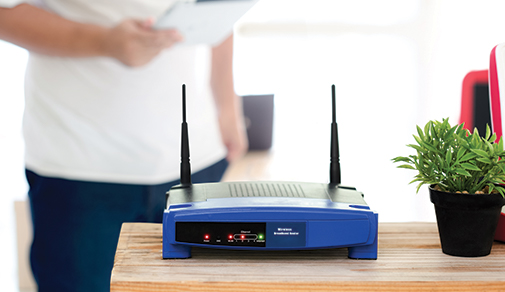5 Popular Routers Compared to Keep Your Work Frustration-Free
Thursday, Aug 27, 2020 · 4 minutes


ROUTER
Thursday, Aug 27, 2020 · 4 minutes
Everybody in today's generation depends more on the Internet than ever before, whether at home for work-from-home use or for streaming without interruption. All this requires high-quality and stable Wi-Fi. So, when new entrants constantly arrive on the market, one may wonder which Wi-Fi router is best suited for home use. Here, one can also find the minimum essentials of how to choose the best Wi-Fi router, secure one's network, and effectively utilize the router in this one-stop shop for understanding how to choose the best routers around: a roundup of the best Wi-Fi routers for home use in India.
This varies depending on the needs of your Internet, the size of your household, and how many devices are connected. Potential considerations for which is the best wifi router for home use Include:
The router should have compatibility with the new-gen WiFi 5 or Wi-Fi 6. These promise faster speed, lower latencies, and much better connectivity for multiple devices.
For large homes, a router with extended coverage or mesh Wi-Fi systems is ideal. Smaller households can manage with single-unit routers offering a decent range.
Dual-Band Routers: Offer 2.4GHz and 5GHz frequencies, suitable for moderate usage.
Tri-Band Routers: Add an extra 5GHz band, perfect for heavy streaming, gaming, or multiple devices.
If you have many smart home devices, laptops, and smartphones connected simultaneously, choose a router that supports high device density.
Parental rule setup, guest networking, and Quality of Service (QoS) settings are some of the settings that you should check out.
The prices of Wi-Fi routers can vary greatly. So find the router within your range but enough for those features you want.
You should know how to secure home WiFi router so that you can protect your data from hackers and unauthorized users. Follow the below easy steps to secure your wifi:
Some default usernames and passwords are easy to guess by somebody who merely knows you and guesses. Just change these credentials immediately to something unique and complex.
Enable WPA3 or WPA2 in your router settings. This means that the network is secure. Do not ever use WEP because this is easily hacked.
Router manufacturers frequently release firmware updates to patch vulnerabilities. Keep your router updated to ensure maximum security.
Disable remote access to your router’s admin panel unless necessary to prevent unauthorized control.
Create a separate guest network for visitors to keep your primary network private.
Always monitor the devices that are connected to the network and disconnect all those that do not have native connections.
Modern routers are built with features such as internal firewalls and are great for protecting your router.
Using a WiFi router at home involves more than just plugging it in. To know how to use WiFi router at home more efficiently, you may follow these steps:
Centralize the router while placing it away from thick walls, metal objects, and electronic gadgets that might hinder the signal.
After setting up your router, connect your devices by entering the Wi-Fi password. For desktops or gaming consoles, it would make more sense to use the Ethernet cable for a more stable connection.
The router configuration settings can be done by logging into the admin panel with a preference for SSID-Wi-Fi identification, password interventions, and security protocol protocols.
Use apps or tools to test your Wi-Fi speed and optimize settings for better performance.
Enable QoS settings to prioritize bandwidth for critical devices or activities, such as video calls or gaming.
Here’s a list of the best Wi-Fi routers for homes in India that cater to various needs and budgets:
Dual-band supports a max speed of 1200 Mbps, is reasonable and reliable, and is best for properties of small to moderate sizes.
Dual-band speed of 1500 Mbps. Offers parental controls and advanced security features.
Wi-Fi 6 provides a maximum speed upto 10.8Gbps. Designed for heavy usage, such as streaming and gaming.
A double band router with four antennas for better range. Excellent price-performance ratio.
This device comes free with Jio Fiber broadband plans. It delivers wonderful speed.
Dual-band router goes up to 1200 Mbps speed. Very easy to set up and is well-suited for budget-conscious buyers.
Single-band router with smart app control. Best suited for small households and light internet usage.
The determining factor of what is the best Wi-Fi router for home India, is different for different people as per their needs. Speed, coverage, and number of connected devices together play a crucial role in determining the correct Wi-Fi router for your house. One should not forget that the most important part of a Wi-Fi router is the security. So always ensure that the firmware of the router is updated.
Position your WiFi router well and configure it properly. It can create a completely different world of experience while enjoying the internet. Invest in a router that meets all requirements for connecting to your devices and enjoy seamless connectivity. Also, check out the best broadband plans to select reliable internet options that fit well with your router for an easy online experience. Visit our page and select your city to get started.
102

The New Social: How High-Speed Internet is Redefining 'Quality Time' with Friends and Family
Read more399

How ACT SmartWi-Fi is Redefining Home Internet in 2025: The Age of AI-Powered Seamless Connectivity
Read more154

From Bandwidth to Intelligence: How AI Is Redefining Business Demands from ISPs
Read more
A referral link has been sent to your friend.
Once your friend completes their installation, you'll receive a notification about a 25% discount on your next bill
![]() Please wait while we redirect you
Please wait while we redirect you

![]() One of our representatives will reach out to you shortly
One of our representatives will reach out to you shortly

One of our representatives will reach out to your shortly
![]() Please wait while we redirect you
Please wait while we redirect you

Please enter your registered phone number to proceed

Please enter correct OTP to proceed


Dear customer you are successfully subscribed
Please wait while we redirect you

Your ACT Shield subscription has been successfully deactivated

Dear user, Your account doesn't have an active subscription

Dear customer Entertainment pack is already activated.
Please wait while we redirect you